Translated by Greg Rice from the Czech original.
At the request of many reenactors, who are interested in early medieval warfare, my colleagues Roman Král, Jan Zajíc, Jan Bělina, et al. and I decided to write an article that would provide a comprehensive commentary on the use of padding under armor and fabric armor in the early Middle Ages. Given that there is no extant archaeological evidence, we are forced to speculate and discuss dubious literary references, iconography and tested, firsthand experience. In this article, we will formulate a list of design assumptions.
The need for padding under mail armor
Mail armor is constructed of connected rings of metal. It is logical that the mail armor and possibly other types of armor were used in combination with padding. Mail, which was the most widely used metal armor in Scandinavia, provides good protection against edged weapons and effectively disappaites the force of a blow. If it was worn without padding, a strike to the body would cause surface and internal damage. For the Viking Age (and indeed throughout the early Middle Ages) padding is never directly mentioned as part of combat equipment (mentioned as gerðar, herváðir and herklæði). The same applies to the surviving Scandinavian figures (see eg. Archer 2013) – armor lying close to the body and the undercoat is not noticeable. Padding as the bottom layer can easily be overlooked, but more significantly – when the armor was depicted, padding was not important for either the artist or the viewer of the piece of art; even though padding is as important as the other parts of armor. However, there are illuminations of contemporary European armor, in which the padding is shown (see eg. Skodell 2008), and we will try to show the parallels in contemporary padding across Western and Northern Europe.
The material of the padding
The best protection against the strike is layered textiles and/or leather. In the European reenactment the current trend is to produce fabric gambesons that are a few centimeters thick, but scientific investigation (see list at Archer 2014) suggests that two textile layers of fabric or a combination of fabric and leather were used. Iconography, showing the armor close to the body, could support that idea. We validated the use of few layers of wool (up to three) in modern (Eastern style) battles; the warrior is not restricted in movement and is fairly well protected against swords. Axe and spear, however, are problematic due to the force they generate. Similarly, we validated a thinner layer of felted wool.
Sagas and other sources, including The Book of the Hird (Hirðskrá) and The King’s Mirror (Konungs skuggsjá), mention textile armor treyja and panzer / panzari (Falk 1914 : § 87 + § 90; 181 – 182, 185 – 186). These two words were introduced into Old Norse from Middle Low German and they denote multi-layer linen gambesons of High and Late Middle Ages (Hjardar – Vike 2011: 194 – 196). In the Bayeux Tapestry armors are so simplied, they can represent mail, scale, lamellar armors or even gambesons, which are quilted in vertical or diamond patterns. In any case, they may be linked to professionalization of the army in 11th century.
Style
Determining what style of the padding was used is probably the most difficult of all to answer, because it requires knowledge of contemporary clothing. It can be assumed that the cut of clothing was not entirely consistent over all the lands that the Norse enhabited. Also, it can be postulated that there were gradual improvements – i.e. the strengthening the individual parts and increasing the number of layers with the need of quilting.
Apparently, most of warriors in Sagas of Icelanders fought without armor, which can be interpreted as they could not afford quality armor or they acted too spontaneously to think about protection. However, from two extreme examples (Helgi, the hero of Vápnfirðinga saga, binds a big stone to his chest to avoid the injury, and Þóri Þorsteinsson, the fighter of Hákon the Good and veteran of Battle of Fitjar, cut a hole in an oxen hide and put that over his head) showing the same kind of ad hoc improvisation and the pattern of not having the armor in the fight. In some cases, warriors of sagas put on festive tunics before a fight; in the most dramatic moments of their life, fashion was more desirable than good protection. Frankish and English illuminations from the 10th – 12th centuries depict a variety of warriors clad only in caps and tunics. It is reasonable to assume that padding was virtually identical to those typical, civilian clothes, and their protective function was achieved by layering them. That means, a classic tunic (kyrtill/skyrta), knee-length garment without buttons or fastening, with long sleeves and gores. The neckline could have a lapel and collar to protect the neck, as Skjoldehamn and Guddal tunics. Likewise, coats (Klappenrock) or Eastern caftans with buttons could, of course, serve the same function.
This solution is illustrated in at least a few sources. The first is the illumination of the Anglo-Saxon version of The Psychomachia of Prudentius (fol. 18v, see the picture), which dates back to the late 10th century. In this illumination one can see two fighters – dancers in short ring shirts with dagged edges and under tunics that reach the knees and wrists. Practically the same solution appears in several manuscripts illuminations from the 10th – 11th century (see eg. a scene from The Book of Maccabees of St. Gallen, Fulda Sacramentary, The Golden Gospels of Echternach, The life of St. Albin and Stavelot Bible). There are also literary sources with statements about fabric under armor, namely Saga of Magnus the Good (ch. 29), which states that “King Magnus threw off from him his coat of ring-mail, and had a red silk shirt outside over his clothes [ok hafði yzta rauða silkiskyrtu] […].”
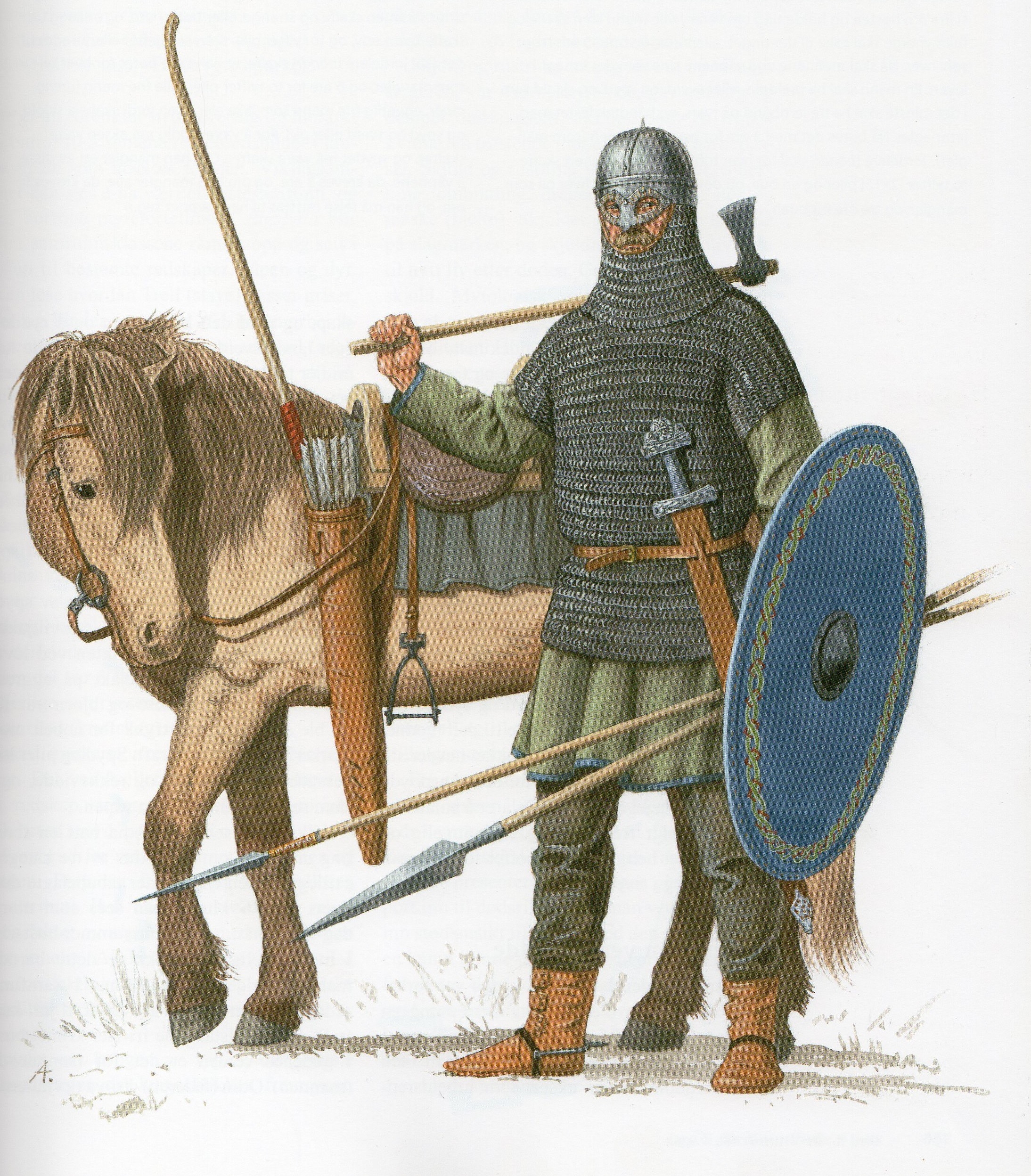
This short quotation forces us to imagine a padding as several layered tunics. Personally, we use this solution and it allows the wearer to freely add / remove the number of layers, clean tunics separately and finally use separate tunics outside the combat context. Two Norwegian finds – Skjoldehamn and Guddal – contained paired tunics, which have been experimentally proven by us to be a good protection against cold and padding worn under the mail armor.
We can also imagine that padding could be made from tunics sewn together showing that padding is a special war garment that hardly finds application in a non-combat situations. It is often argued that Byzantine sources describe padding that is similar to a gambeson. The Strategikon mentions that tunics below the mail varied in quality from linen to goat’s hair or rough wool (Adams 2010: 98). An anonymous treatise on the strategy from the 6th century gives a particularly interesting testimony:
“There should also be a space between the armor and the body. It should not be worn directly over ordinary clothing, as some do to keep down the weight of the armor, but over a garment at least a finger thick. There are two reasons for this. Where it touches the body the hard metal may not chafe but may fit and lie comfortably upon the body. In addition, it helps to prevent the enemy missiles from hitting the flesh […].”(The Anonymous Byzantine Treatise on Strategy, §16, ed. G. T. Dennis )
In Scandinavia, the existence of such a one-pieced textile represents the term treyja, which could mean that specialized clothing began to be used in the later period (11th / 12th century onwards), but due to the nature of our sources, we can neither accept or reject this idea with 100% certainty. We have to admit that both variants are possible. Thickness of the special garment could be around 1 centimeter. During the making of such a piece of clothing, we would personally avoid excessive quilting; we would only stitched the layers at hems.
Scandinavian iconography suggests that the length of padding adapted to the length of chain mail. It is even possible to think about the intergral lining of the mail armor, as the Bayeux Tapestry suggests; it shows armors carried on spears, not worn by anyone, with wide coloured borders, perhaps suggesting that the padding was in some way integral to the armor itself, and scenes on the border also depict armor being removed from men that are clearly naked underneath, which also suggests integral padding that is removed with the mail. The Psychomachia of Prudentius and other contemporary illuminations, however, shows the opposite. With few exceptions, we can say that until the early 11th century, Scandinavians surely used shorter mail armors, with the length up to 70 cm and short sleeves. Mail components, such as protection over the neck or legs, were missing. During the 11th century, we can observe how the armor lengthened, which was due to Continental influence and which culminated in the use of a complete mail armor set.
We are strictly against the use of modern padding, which is haphazardly stitched together and which looks more like rags or slave clothing. The padding – no matter how it looked – had to be aesthetically pleasing and had to reflect the status of the owner. Some reenactors and organizers of festivals like to say there are no sources, so every version is possible. The goal that we reenactors should achieve is the least disturbing look that is in accordance with what we can see or read in sources. Now we will compare the Viking Recreation combat of the Modern Western European style to Modern Eastern European style. Modern Western (example here) is a style where the head is not a legal target and the force of blows is much less. This style combat is so safe it allows one to use no armor, and the historical look can be maintained. On the other hand, Modern Eastern style fighters (example here) are focused on hits with full force to protected target zones – a system that is illogical from the historical perspective. Western tradition allows to use a tunic as the main protective layer, while it is better to use more layers in the Eastern approach. The result we would like to achieve is that the armor can look historically correct in both styles, but with the different number of layers. On several occasions, we have fought in modern Eastern style battles with nothing but one tunic worn without mail armor; it turned to be a fight for our lives, the realistic feeling which gives one so much adrenalin to ignore hits from blunt weapons. Layered tunics, whether sewn or not, could be a good compromise between these two extreme approaches.
Reconstructions
We hold the opinion the image of reenactors is crucial in the reenactment. We strove for a quality article, but we can not completely demonstrate our thoughts without photos. Therefore, you can find a gallery below. We hope that the gallery will extend in the future. If you have any image of the appropriate padding, you can, of course, send it to us and we will publish it.
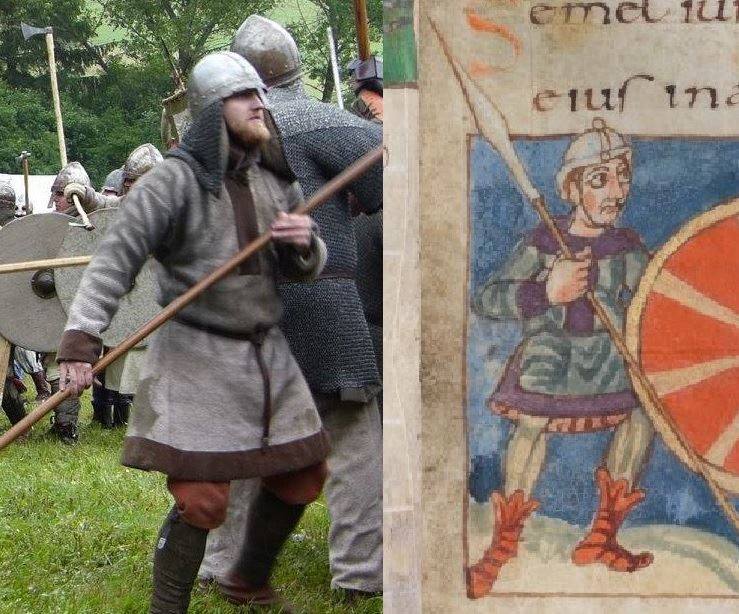

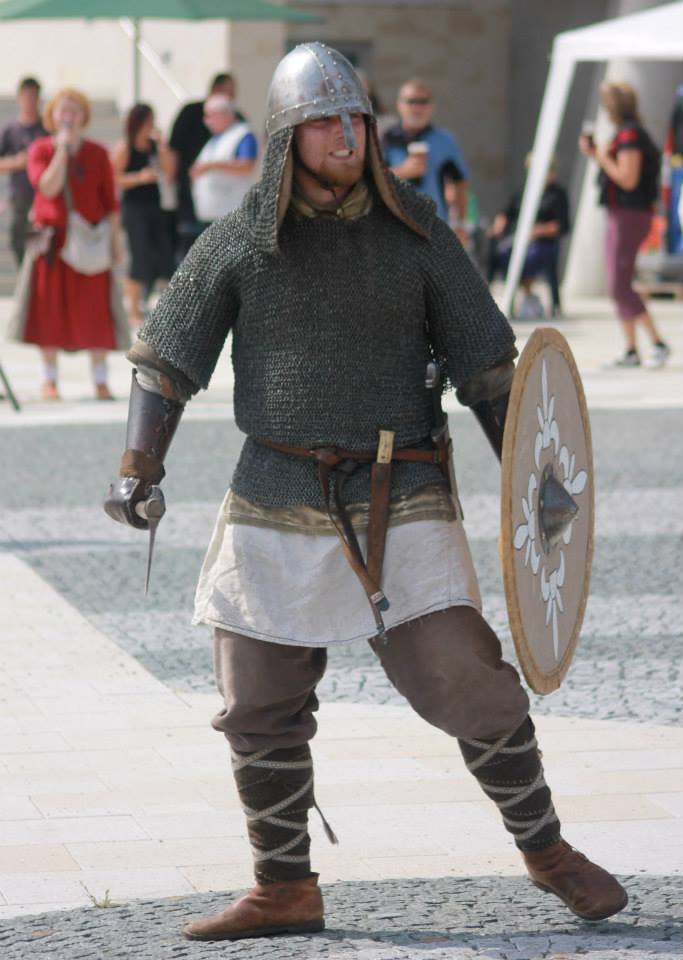



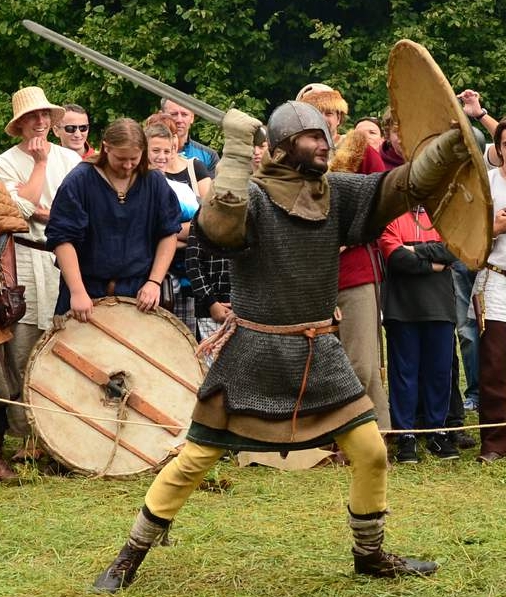










We believe that the problem has been overlooked so far and the battlefields are full of non-historical armors that look more like the Michelin-Man. In order to change the current trend, the discussion has been led, and therefore we are open to opinion and are willing to participate in further debates. The article was well accepted and a separate addition, “War coat – an experiment“, was written. The most important quote from the article says: “For a traveling fighter, it is impractical to carry civilian clothes and extra special combat protection, I think. It is more advantageous to combine these two requirements into one.“
I hope you liked reading this article. If you have any question or remark, please contact me or leave a comment below. If you want to learn more and support my work, please, fund my project on Patreon or Paypal.
Sources and recommended links
The Anonymous Byzantine Treatise on Strategy. In: Three Byzantine Military Treatises, ed. a trans. George T. Dennis, Washington 1985: 1–135. Available at: https://oniehlibraryofgreekliterature.files.wordpress.com/2015/09/three-byzantine-military-treatises-by-george-t-dennis.pdf.
Saga of Magnús the Good (Magnús saga góða). Available at: http://www.heimskringla.no/wiki/Sagan_af_Magn%C3%BAsi_g%C3%B3%C3%B0a.
ADAMS, Noël (2010). Rethinking the Sutton Hoo Shoulder Clasps and Armour. In: Entwistle, Chris – Adams, Adams (eds.). Intelligible Beauty: Recent Research on Byzantine Jewellery, British Museum Research Publication 178, London, 83-112
ARCHER, Gavin. Mail Shirts, in: The Viking Age Compendium, 2013. [online]. [ 2015-02-03]. Available at: http://www.vikingage.org/wiki/index.php?title=Mail_Shirts.
ARCHER, Gavin. Jacks and Gambesons, in: The Viking Age Compendium, 2014. [online]. [2015-02-03]. Available at: http://www.vikingage.org/wiki/index.php?title=Jacks_and_Gambesons. See the bibliography in the end.
FALK, Hjalmar. Altnordische Waffenkunde, Kristiania 1914.
HJARDAR, Kim – VIKE, Vegard. Vikinger i krig, Oslo 2011.
SKODELL, Henry. Schutzausrüstung des 11. Jahrhunderts in Mitteleuropa, in: Reenactment.de, 2008. [online]. [2015-02-03]. Available at: http://www.reenactment.de/reenactment_start/reenactment_startseite/diverses/kitguide/kitguide.html.
Roman subarmalis – thoracomachus – online.
The oldest gambeson from Bussy-Saint-Martin – online.
The reconstruction of quilted gambeson from the 13th century – online.
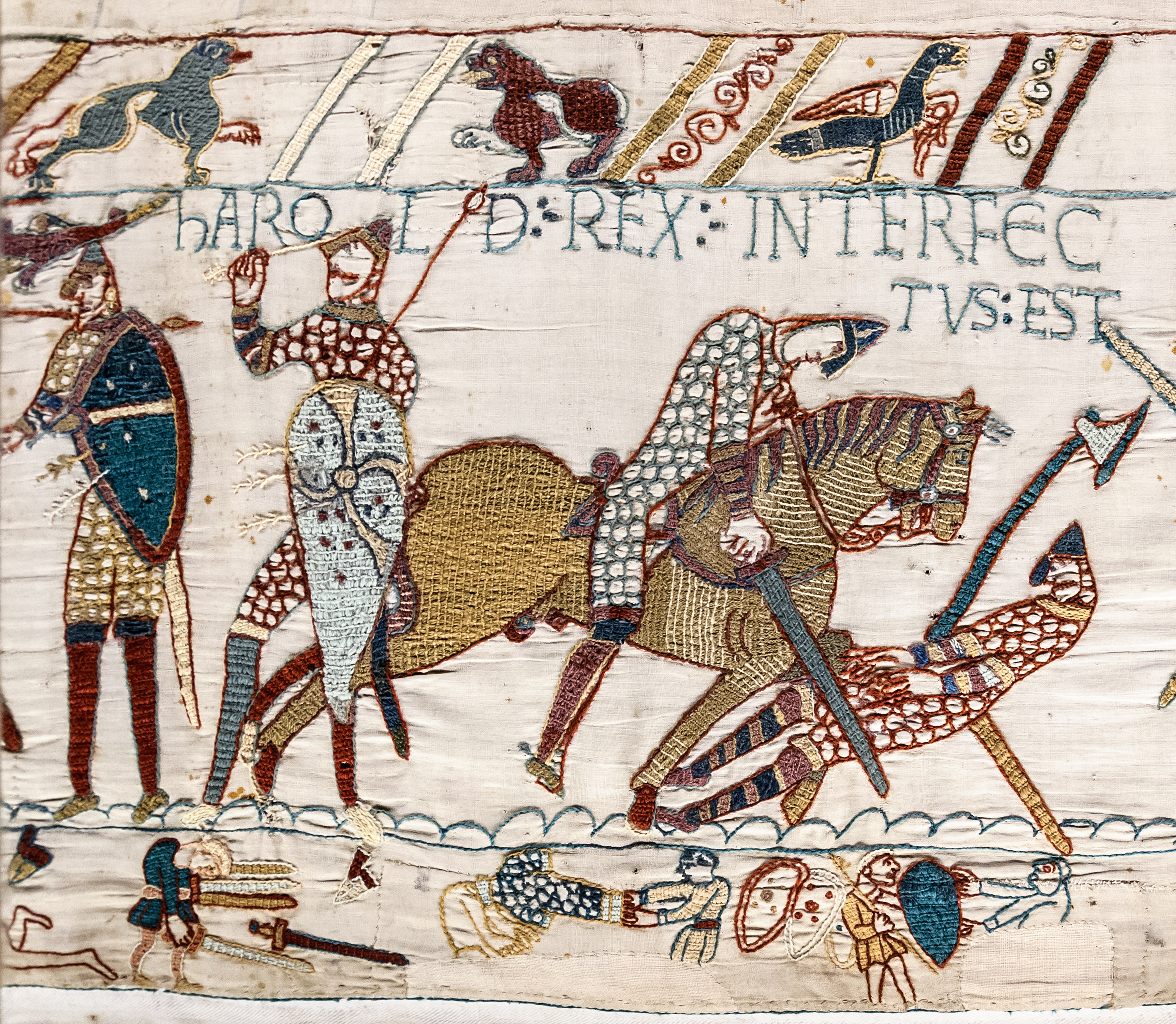



One Response
Hail!
How are you?
Part of my background is Scandinavian. I like you’re link. I study Viking Age lot. I do have my own Viking helmet, I am getting my own Viking Linen Tunic, blue, it’s coming tomorrow. I will be making my own Viking Clothing’s, like Viking Tunic. I never been too any Scandinavian Countries before, someday I love to go. Here in Toronto Canada we have Viking group, I will be joining with then. I will e doing Viking Age combat with this Viking group in Toronto Canada. I like all you’re pictures.